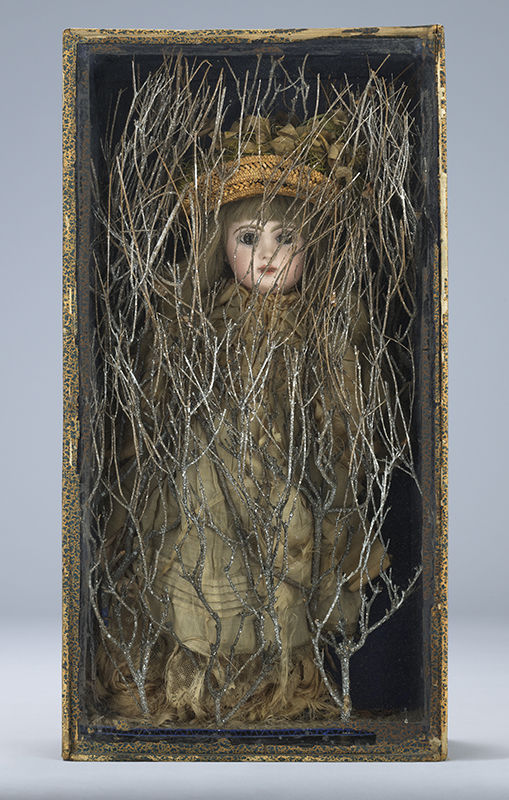Joseph Cornell (1903-1972) was eccentric and reclusive and went about NYC and environs collecting little bits and pieces of things: shells, old diaries, album covers. He felt there were certain objects that belonged together that had been separated, possibly by decades, and made otherworldly, magical assemblage boxes that purported to reunite them.
This idea of making connections, of reuniting things that have been lost or separated from each other is dear to the heart of a follower of the Gospels.
In the Parable of the Lost Sheep, Jesus says, “What man among you having a hundred sheep and losing one of them would not leave the 99 in the desert and go after the lost one until he finds it? And when he does find it, he sets it on his shoulders with great joy and, upon his arrival home, he calls together his friends and neighbors and says to them, ‘Rejoice with me because I have found my lost sheep’” (Luke 15: 4-6).
The twist is that most people would be glad to let the rogue sheep go. The heck with him if he insists on wandering off! Only someone who has felt him- or herself to be lost, only someone who has suffered the terrible exile of feeling cut off from the herd, would so yearn to find, and to bring back home, the one lost sheep.
In “Dime-Store Alchemy: The Art of Joseph Cornell,” poet Charles Simic describes his work as a place “where chance meets necessity.” The assemblages are his “premise, his metaphysics, and his religion, which I wish to understand.
“Joseph Cornell could not draw, paint, or sculpt and yet he was a great American artist. He roamed the streets of New York from the late 1920s until his death in 1972, foraging in used bookstores and junk shops. ‘My work was a natural outcome of my love for the city,’ he said.
“Here are some of the things he found and placed in a box called ‘L’Égypte de Mlle Cléo de Mérode cours élémanetaire d’histoire naturelle,’ which he constructed in 1940:
“Doll’s forearm, loose red sand, wood ball, German coin, several glass and mirror fragments, 12 corkstopped bottles, cutout sphinx head, yellow filaments, two intertwined paper spirals, cut-out of Cléo do Mérode’s head cutout of camels and men, loose yellow sand, six pearl beads, glass tube with residue of dried green liquid, crumpled tulle, rhinestones, pearl beads, sequins, metal chain, metal and glass fragments, threaded needle, red wood disc, bone and frosted glass fragments, blue celluloid, clear glass crystals, rock specimen, seven balls, plastic rose petals, three miniature tin spoons for a doll house.
“Cléo de Mérode, by the way, was a famous ballerina and femme fatale of the 1890s.”
In Joseph Cornell’s“Vision of Spiritual Order,” Lindsay Blair observes of Cornell’s approach: “Everything was fluent, fluid and contingent — part of the process.”
“Cornell developed strategies to encourage his mind to make connections, to be in a state of readiness, of receptivity. … Thus Bacall becomes associated with Delacroix and Cinderella, with penny arcade machinery and Christian Science through his receptivity to other associations than the ones Hollywood had impressed upon her.”
This disciplined state of readiness and of receptivity brings to mind another Gospel passage — the Parable of the Wise and Foolish Virgins, which begins:
“Then the kingdom of heaven will be like 10 virgins who took their lamps and went out to meet the bridegroom. Five of them were foolish and five were wise.
“The foolish ones, when taking their lamps, brought no oil with them, but the wise brought flasks of oil with their lamps. Since the bridegroom was long delayed, they all became drowsy and fell asleep. At midnight, there was a cry, ‘Behold, the bridegroom! Come out to meet him!’”
The wise virgins get up and trim their lamps. The foolish virgins beg them for some oil, and they say, “No, go out and buy some yourselves.”
“While they went off to buy it, the bridegroom came and those who were ready went into the wedding feast with him. Then the door was locked.
“Afterwards the other virgins came and said, ‘Lord, Lord, open the door for us!’
“But he said in reply, ‘Amen, I say to you, I do not know you.’ Therefore, stay awake, for you know neither the day nor the hour’ ” (Matthew 25:1-13).
Being fluent and fluid and receptive is the oil with which we, along with the wise virgins, keep our lamps lit. Because when we are open and receptive to all the world has to offer, and all the world has to teach us, then everything becomes illuminated from within.
Then we see that everything is, or can be, connected to our quest for beauty and order. Everything “belongs”: old dolls, decrepit diaries, discarded buttons. Difficult people.
The foolish virgins aren’t the ones who forgot to do their shopping. The foolish virgins are the ones who haven’t trained themselves to be awake to the inexhaustible, crazy gift.
Heather King is a blogger, speaker and the author of several books.
